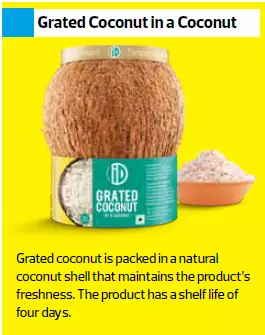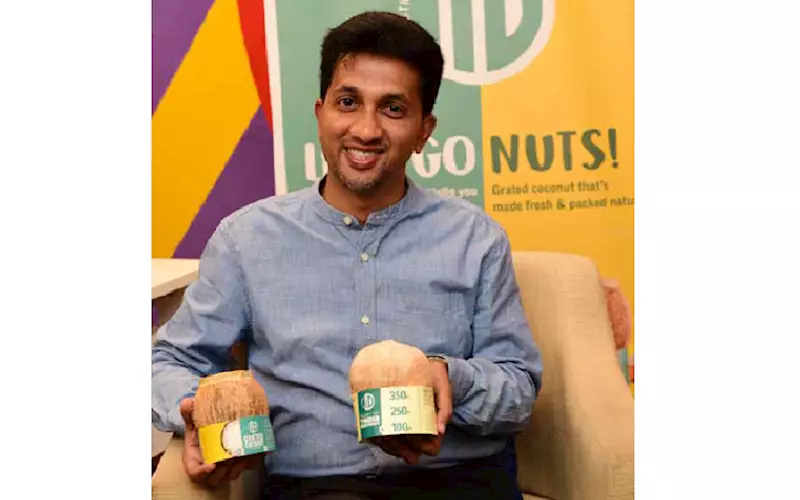Packaging with a natural connection
How often do you come across a product available in the purest form of packaging – the nature itself? With its coconut packaging, iD Fresh has added another feather to its cap of packaging innovations. PC Musthafa, co-founder, iD Fresh Food, in a conversation with Abhishek Muralidharan of WhatPackaging?, explains how the company took inspiration from nature
20 Nov 2020 | By Abhishek Muralidharan
Abhishek Muralidharan (AM): Is fresh food the burgeoning trend?
PC Musthafa (PM): Fresh is the future. People are becoming more health conscious, which is leading to a fresh revolution, which is not discernible yet, but it is definitely happening. There are already numerous fresh food stores being established in the world, which is set to multiply soon. Products with a long shelf life are disappearing. This is why we ventured into fresh food category in the first place. When we launched Tender Coconut, in the same store, they were selling 10-15 packs of a coconut drink, which has now reduced to almost zero. Similarly, when we launched idly and dosa batter, the conventional powder disappeared. The same was the case when we introduced our parotas. All this made me believe that anything can be sold fresh.
AM: We see iD Fresh food products populate the retail shelves in Mumbai. Has iD become ‘The’ fresh food brand here?
PM: In some markets, we are ‘The’ fresh food brand, but there also exist some markets that we are yet to venture into. If we look at the Bengaluru market, we have a 75% market share. In the Mumbai market, we have around 90% market share. If we add Pune to that market then it becomes a 95% market share. We have also started catering to New Delhi and Kolkata markets. Overall, we would be easily doing a business of around Rs 260- crore today.
AM: How much do you garner from eCommerce sales?
PM: Our products are available on select platforms such as Amazon Pantry, Milkbasket and so on. As of today, only around 2.5% of our revenue is coming from online platforms. So, if I have to bifurcate, 93% of our business comes from B2C channels such as modern and general trade. Our plan is to take our eCommerce sales to 4% in the next two years.
AM: iD is a company which has never shied away from social media presence. This, we believe, boosts brand visibility and also consumer connection, especially among the millennials. What role have these social media platforms played for iD?
PM: I think the best part about social media is the fact that people love stories. I feel that social media is the ideal platform to create a story and also propagate it. Well-crafted stories are vital for creating a brand and this is the reason all our campaigns have been successful. Social media is the number two platform today after TV, which means it has overtaken print media as well. Moreover, for a company like us, which has its presence in most of the metro-specific cities, social media seems to be the right platform for us. Social media helps us connect with our existing customers and also with people who are yet to try our products. I have learned that two concepts work very well in social media for a brand like iD – emotional stories and product and packaging innovations.

iD Fresh has been in the forefront of packaging innovations
AM: What role does packaging play for your company?
PM: We have tried to get something more out of packaging from day one, right from our initial product – the idly and dosa batter. We have always been asking questions – can packaging deliver functionality? Can we do something to bring an authentic feel to the pack? Can we use natural packaging as it is? This has been our thought process throughout our company’s journey.
AM: iD Fresh has always been in the forefront of packaging innovations...
PM: In 2014, we innovated a packaging for dosa batter, which enables the product to be dispensed directly from the pouch. The package is more like a transformer as it functions like a pouch during transit and storage, but when you open the zip lock, it becomes a dispensing tool.
Similarly, when we introduced our vada batter package into the market two years ago, it delivered great functionality as well. So, just to give out some numbers, the awareness level of the brand iD was around 24-25% in the Bengaluru market, two years ago. After vada batter’s introduction, we have learned that our awareness level has gone up to 76%,which is three-fold. People really loved the packaging concept – when they squeezed the spout, they were able to make a perfectly round-shaped vada. We also released a oneminute video on how to make vada using the package, which went viral. The product helped us get global attention. That is the power of innovation.
AM: What about your filter coffee packaging for which you recently launched a strategic business unit?
PM: For the filter coffee, we used packaging for two criterion. Firstly, to ensure the product can be used in travelling. The sachets enabled customers to carry their favourite filter coffee on their journeys out of India. The idea really helped. Secondly, the family pack, which had a 3D tumbler design to provide a nostalgic feel to the package.
AM: Where did the idea of grated-coconutin- a-coconut come from?
PM: The answer is simple! We launched idly, dosa and vada. So, what’s missing in the fresh food portfolio? Chutney! Now, because of our philosophy of producing 100% natural products without the use of any chemicals or preservatives, it was a tough task for us to produce fresh chutney, as it has a very limited shelf life. But we knew that if we were able to provide grated coconut, making chutney is a fairly easy task. Thus, once we decided on the product, we tried different packaging options to maintain the product’s freshness without the use of preservatives or chemicals. But nothing worked. Then a thought struck. Why don't we use nature’s own packaging as it is? And the idea came out in flying colours.
AM: In a product such as tender coconut, when you integrate nature in packaging, it can have some variations; in this case, two shells won't be exactly the same. How did you address this issue?
PM: The shell variations are built into the packaging design. First, we remove the outer shell and then we categorise the coconuts into different variants based on the size, weight, water and pulp content, sweetness level and so on.

AM: How were you able to predict the water content with 95% accuracy?
PM: It’s a matter of common sense and sci-ence. We analysed thousands of coconuts, which enabled us with a lot of predictability on identifying what's inside the coconut without opening it. We used common sense in procuring the coconuts with the right maturity level from the right farms. Then, after shaving the husks, we were able to measure the weight and volume of the coconut. Now, we have vital information – weight, volume, farm, maturity level and type – about the coconut without even opening it. This data enabled us to predict other factors such as water content, pulp (malai), sweetness and total edible quantity.
AM: This was indeed a perfect employment of common sense and science...
PM: Yes. It was due to the accurate information that we had gathered, we were able to introduce the tender coconut with the message of #KnowYourCoconut (KYC), as the packaging included all the information one needed to know before opening the coconut.
 AM: Were there any challenges in getting the perfect seal for the grated coconut package?
AM: Were there any challenges in getting the perfect seal for the grated coconut package?
PM: It is exactly the same as the concept of cork on the wine bottle. The cork expands and seals the coconut, maintaining the freshness. In case of tender coconut, we have provided a small groove on the coconut that is sealed with a sticker for the straw to be inserted. In addition, we have provided a large groove that enables the customers to open
the coconut to scoop the pulp.
AM: How many tender and grated coconuts are you currently producing? Are you equipped with the necessary supply of coconuts if the demand shoots up?
PM: We have tied up with vendors in different parts of South India. Presently, we are producing 1,000 coconuts per day, which is just being supplied in 100 outlets in Bengaluru. It will take some time to increase the production to match the demand. And to cater to this demand, we will have to do vendor develop-ment and work with more farmers to get us the right quality of coconut every time. All these steps are in the strategic pipeline.
AM: Any eco-friendly package product in the pipeline?
PM: Our dream is to move to eco-friendly plastic-free packaging for all our products. But unfortunately, as of now, we don’t have a solution, as it is a tough ask to find a suitable and practical alternative. This is an area where we have been working on for years. As a result of which, we have at least two new products with plastic-free packaging now – iD Smart Sip Tender Coconut and iD Grated Coconut in a Coconut.
AM: Have you undertaken any measures to collect and dispose of your post-consumer packaging waste?
PM: We worked with an agency to collect the plastics and dispose them off. Now, there is also a commercial process happening behind all of them. The problem we encountered was that we are not able to pick up the clean package back. So, whichever plastic package we were able to collect through the agency, we disposed it off properly. However, I strongly believe that this is not the way we should look at the overall packaging. We need to find a way where we can reuse God's own packaging and maintain its freshness. I think that is a key challenge today














 See All
See All